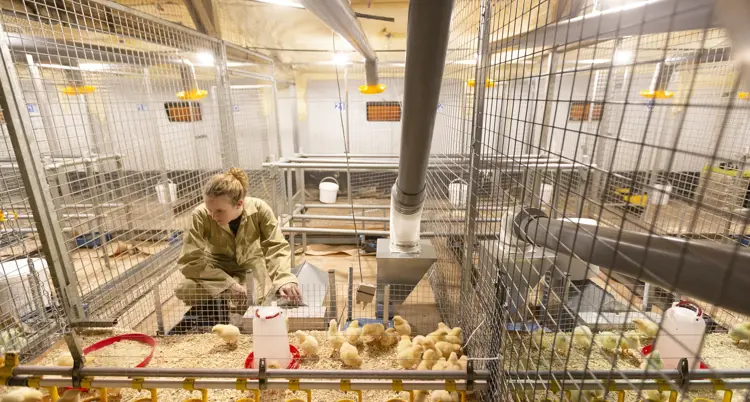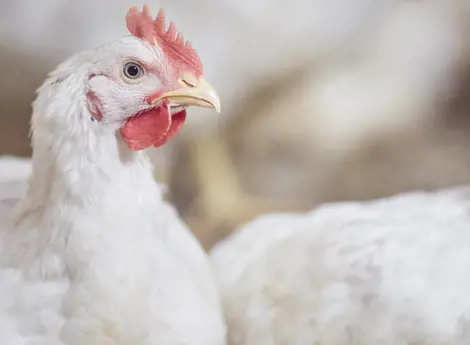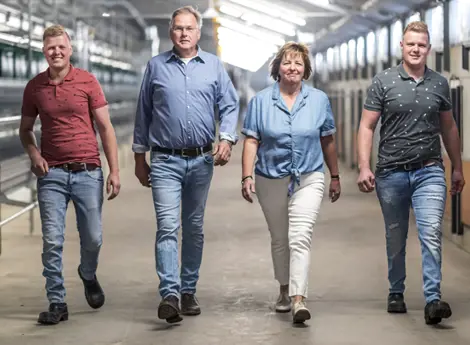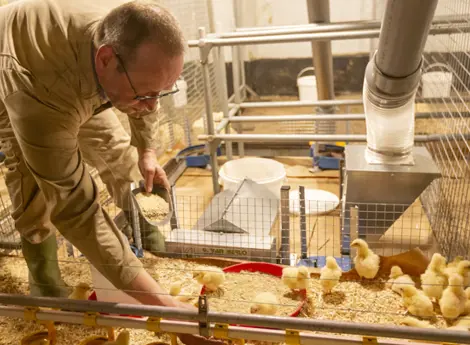
Breeding
After having been loaded into the coop, the chickens need to find their way around the area and find food and water as quickly as possible. For this reason, it is recommended to keep the lights on continuously for the first 24 hours and then to turn them off for 1 hour at night from the 2nd to the 7th day so the chickens can gradually get accustomed to the dark periods. After lights out, their first reaction is to screech, but later on they will sit down on their beds and remain inactive. The light intensity should be greater than it is during the later stages of fattening. Specifically, it should be between 25 and 40 lux. Setting the intensity is a simple matter in the case of modern coops, which allow the light intensity to be regulated. Older farmers often address this issue with additional lights or bulbs that only light up during this period.
Growth phase
It is a good idea to give the chickens 4 to 6 hours of darkness per day from the 8th day up until 5 days before they are removed from the coop. In the case of six hours, we recommend dividing this time into two periods over the course of the day – the first one during the daytime, and the second at night. If the lights are turned off during the day, the hall needs to be specially equipped in order to achieve true darkness, otherwise, the chickens will remain active.
The reason for dividing this period of time is that it takes approximately 6 hours for the chickens to digest their food, so they will be very hungry after the lights go on. Their skin can be damaged by scratches when chickens compete to make it to the feeder first. The chickens do still go to eat even if the dark period lasts longer. Another good reason to split up this period of time is that if the chickens sleep too long, the quality of their bedding will suffer and the chickens will ultimately have problems with their feet.
The dark phase is especially important for proper bone ossification and calcium metabolism. It also reduces mortality caused by cardiovascular failure or problems with the feet, and decreases the rate of poultry meat defects. However, it is essential to set a regular biorhythm for the chickens by consistently turning off the lights at the same time of day. They get used to this schedule and eat right before they expect the lights to go out, so that they can digest.
During the growth phase, an intensity of 5 – 10 lux measured at the chicken’s level will suffice. Higher intensities lead to needlessly high electricity costs, as well as making the chickens more active and putting them under stress, which can increase their feed consumption. The most advanced devices on the market measure the light intensity that the poultry actually perceive in a unit known as “galli-lux”
Before slaughter
Some breeders continue the same light schedule until the chicken are removed from the coop. However, it is recommended to slowly increase the hours of light repeatedly, which helps to reduce stress when the chickens are rounded up.
Lighting programme 18:6
|
Age |
Age (in days) |
Hours of lights | Intensity in lux |
| 1 | 1-7 | 24-23 | 25-40 |
|
2-5 |
8-37 | 18 | 5-10 |
| 6 | 38 | 19 | 5-10 |
| 6 | 39 | 20 | 5-10 |
| 6 | 40 | 21 | 5-10 |
| 6 | 41 | 22 | 5-10 |
| 6 | 42 | 23 | 5-10 |
Table 1: Number of hours of light and intensity in lux depending on the broilers’ age
Colour of light
In the past, farmers often worked with information on what effect different colours of light would have on improving production. It is true that many studies have confirmed a positive effect on weight at slaughter or feed conversion. Much research has monitored the effect of green or red light, but these theories have almost never been confirmed in actual practice on farms. Companies that make poultry house lighting, on the other hand, recommend bulbs that best imitate natural sunlight and cover the entire colour spectrum. If only one specific colour were used, it would make it harder for the chickens to see certain details of the equipment in the coop and would prevent them from interacting with other chickens. It is important to keep in mind that the optimum colour spectrum for poultry is slightly different from that for humans.
Flicker effect
Any breeder can easily monitor the flicker effect in their bulbs using a mobile phone. Walk up to the bulb and look through the phone’s camera. Even at high intensities, our eyes can process flickering light to be a continuous image. But poultry see differently, especially in cages, where fluorescent lights are often only a few millimetres from their eyes and constitute one of the stress factors. Flickering is not necessarily caused by the bulbs themselves. An incorrect light intensity controller is often to blame. There are already devices on the market that can measure the flicker intensity of lightbulbs. The extent to which the flicker effect actually affects the technical results when fattening chicken is still under investigation.
Alternating light mode
An alternating light regime, in which several periods of light and darkness are alternated during the day, can also be used to encourage chickens’ activity. Of course, this system is most limited by the quality of the bulbs and by human involvement. Dividing the darkness time into several shorter periods has a positive effect on carcass weight. This is because chickens always respond to lighting by increasing their water and feed intake activity. Thanks to the chickens’ increased activity, this system can also have a positive effect on the health of their feet. The greatest benefit can be observed especially in the first week of life, as it can boost chicks’ feed intake, thus giving them a better start. What causes lightbulbs to burn out?
When inspecting the coop, the farmer often notices places with significantly worse bedding, and the main cause is improper ventilation or draughts in the coop caused by leaky walls. However, the situation is often similar when light distribution in the coop is uneven. Our fattening broilers’ ancestors were birds that inhabited the primeval forests of Asia. This is why chickens always seek out darker environments that give them a sense of security, and conversely shy away from places with excessive light intensity, where they could easily be caught by predators in the wild. If intense and less intense light bulbs are used in the coop, or if any of them are burned out, the chickens will avoid places where the light intensity is higher. They leave their droppings in these places so that the places where they walk around will stay clean. This is why, if you see a spot where the bedding is wet and there is a high concentration of droppings, look up and you may see that the light bulbs above it are lit up more intensely than the ones surrounding them.
If you would like to learn more about this subject, please do not hesitate to contact specialist De Heus.
A list of the literature used is available from the author.






